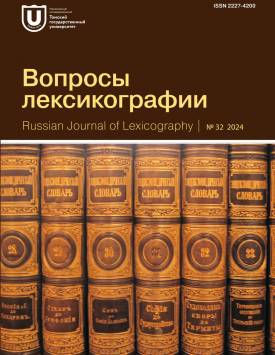Markers of linguistic tolerance/intolerance in modern phraseological dictionaries
The relevance of the article is determined by the need to identify the phraseological capacity of the Russian language tolerance and intolerance, which cannot be done without referring to the data of modern lexicographic sources. Linguistic tolerance is understood as the presence in the language of verbal means available for characterizing the sphere of communication, unfolding in the categories of “one’s own/someone else’s”, and for applying positive judgments, excluding hostility and aggression, in a speech situation of interaction with those who differ in some way from the speaker. Linguistic intolerance refers to the use of humiliating, offensive, disparaging words and statements. The aim of the article is to identify the degree of phraseological marking of tolerance and intolerance in the system of the modern Russian language. The study was conducted with the use of material from a number of authoritative phraseological dictionaries, as well as dictionaries of lexical and phraseological synonyms published after the year 2000. It has been determined that manifestations of linguistic tolerance/intolerance at the phraseological level are procedural indirectly derived units of the semantic class “Attitude”, i.e., units that reveal interpersonal or social relations. These include phraseological units of emotional and evaluative attitude or external manifestation of attitude, affection for contact or, on the contrary, alienation. The same number of semantic signs of linguistic tolerance and linguistic intolerance has been defined, forming the semantic binomials “condescension - contempt”, “sympathy - condemnation”, “responsiveness - indifference”, “attention - rejection”, “consent - refusal”, “conventionality - impudence”. These meanings are recognized as nationally and culturally significant and relevant, forming a special fragment of the Russian language worldview. Quantitative indicators of the representation of phraseological units in the language demonstrate the asymmetry of tolerance/intolerance. In each semantic pair, verbalizers of intolerance dominate, which indicates the low degree of importance of tolerance for Russian linguistic culture. The analyzed units are included in the current corpus of Russian phraseology, since they are found in the dictionaries of all phraseographic publications of the first quarter of the 21st century. The difficulty of parameterizing phraseological units as verbalizers of linguistic tolerance/intolerance is caused by the borrowed nature of the concept “Tolerance”, and, consequently, by the “alienity” of the system of ideas about what attitude and behavior is considered intolerant. The authors declare no conflicts of interests.
Keywords
linguistic tolerance/intolerance, semantic marker, semantic binomial, phraseological dictionary, semanticsAuthors
| Name | Organization | |
| Lapteva Maria L. | Astrakhan State University | hohlina2004@yandex.ru |
| Vasilyeva Yulia A. | Astrakhan State University | gis_00@mail.ru |
References

Markers of linguistic tolerance/intolerance in modern phraseological dictionaries | Voprosy leksikografii – Russian Journal of Lexicography. 2024. № 32. DOI: 10.17223/22274200/32/5
